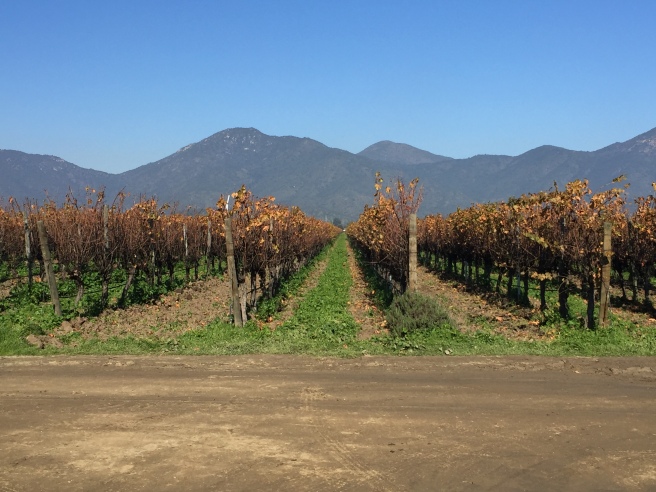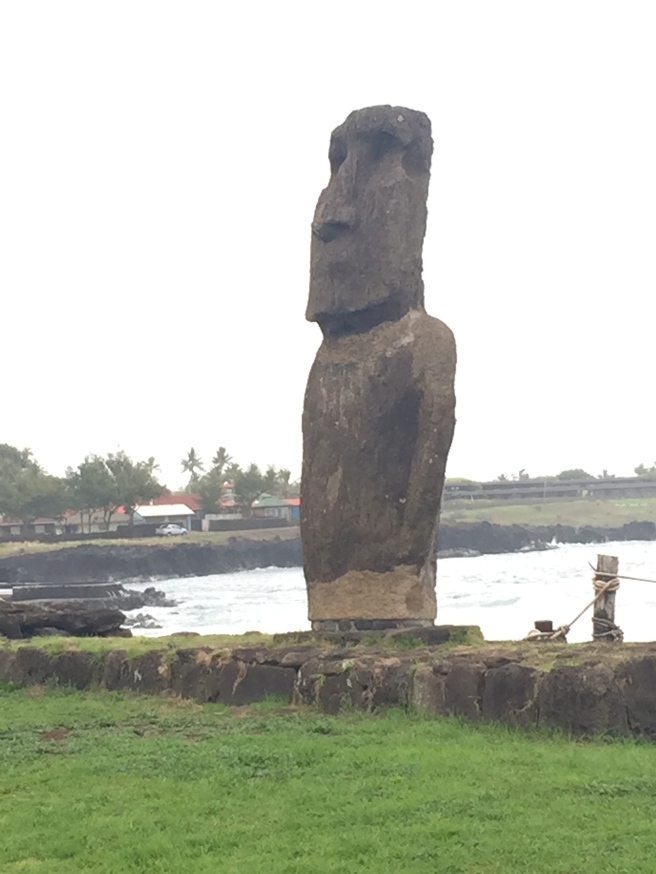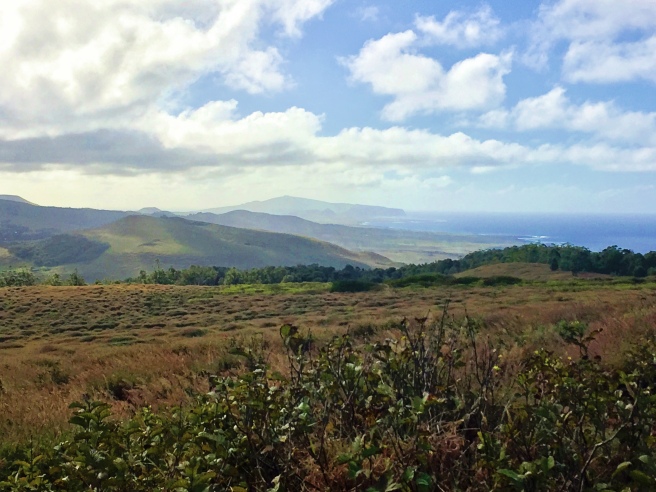
Finally: the long-awaited Chile post! Long…that’s a good description for the journey there. Living in Bermuda of course adds a minimum of two hours to almost any flight path, one more jump to the southern U.S. and then we had eight hours direct to Santiago. I didn’t sleep very well, but check out our sunrise view of the coastal mountain range (above)!
I think your brain is always trying to make associations with things that are familiar to you, so my first impression was that it felt just like flying into Salt Lake City. And then, I saw the Andes.

They are absolutely breathtaking and indescribably huge… unlike anything I’ve ever seen before.
We stayed at the W Santiago, which was sort of in the business and financial area of the city, so it was a pretty quiet neighborhood. Because we arrived bright and early in the morning, we couldn’t get into our room right away, so we checked our luggage and explored the city for a few hours.
First stop: coffee (remember that part where I didn’t get much sleep?). I was looking forward to practicing my Spanish, but almost everyone we encountered spoke better English than my broken, and I’m sure terribly accented, Spanish.

Andrew and I both like to walk through neighborhoods to get a sense of a place. We slowly moseyed toward the mall at the base of Costanera Center Gran Torre—the tallest building in South America. Seriously, a mall? I know. I used to avoid them like the plague, but living on a small island makes you appreciate being able to do all your shopping in one building. We got a few things like rain jackets (those came in handy later on the trip, plus we both needed a new one for back home!), and discovered Cruz Verde, which is sort of like a Walmart (again, I know, gross, but we needed some packaged snacks).
Then, we took the elevator all 64 stories to the very top of the tower—your ears pop on the way up. The view is incredible: You’re eye-to-eye with the tops of the Andes (that first picture of them was taken from the tower), and the entire city sprawls out in front of you. We could even see our hotel!

By the time we got back down to solid ground, we had killed enough time for our room to be ready so we headed back to shower. Yay showers! We had a big day tomorrow, so we headed for an early dinner at Happenings, which was a lovely steakhouse. When I say early, I mean we left the hotel at 6:30, which is just barely on the early side for us… but apparently early bird special status for Chileans! There was only one other (English-speaking) table seated when we arrived, and the host looked downright surprised to have guests already. You guys, there were families with young kids just walking in while we were paying our bill a few hours later. We were so not on Chile time.

But we did have an awesome meal—a delicious prawn appetizer, Andrew had a steak (of course!) and I had a lamb entrée that could have easily fed two people. Like proper old folks, we had one drink at our hotel before heading up to our room for an early bed time!
The next day was wine tour day! This ended up being our favorite day in Santiago—but not for the reason you might think! We hired a guide, so he drove us through the stunning valleys that surround Santiago, and we also enjoyed some of the best food of the entire trip.
Our first stop was a darling restaurant, empty at 11 a.m. except for the owner and her dog, who was cozied up by the wood stove (it was winter in South America, remember!). We had our first authentic Chilean empanadas, and THEY. WERE. AWESOME. Seriously so good, and exactly what we needed to start the day. Our guide had also brought a really nice red that went well with the meal and was mild enough to drink before noon.

You guys, this place was legit. Our tour guide even called his wife to see how many empanadas she wanted him to bring home!


Our first winery was Emiliana—which is an organic, sustainably run vineyard. After a very impressive tour given in both English and Spanish by this lovely young lady below, we enjoyed a flight of some of their most popular wines.


Oops, I accidentally drank from that first glass before I took a picture. Couldn’t wait!

Part of Emiliana’s commitment to sustainability is also a commitment to their employees. They offer personal garden space and the fruits of their olive trees to the workers, and sell the resulting olive oil in the shop, with all the profits going to directly to the growers. Oh, and they also had alpacas (the workers get to keep the wool), so that was entertaining!
 We then headed next door to Vina Morande for a gourmet four-course lunch paired with their wines. This was definitely the best meal we had on the trip—featuring lots of fresh seafood prepared by an amazing chef, who even came out to our table after the meal. Below is a squid ink risotto in an incredible broth, topped with mussels, shrimp and the most flavorful grape tomatoes. So tasty!
We then headed next door to Vina Morande for a gourmet four-course lunch paired with their wines. This was definitely the best meal we had on the trip—featuring lots of fresh seafood prepared by an amazing chef, who even came out to our table after the meal. Below is a squid ink risotto in an incredible broth, topped with mussels, shrimp and the most flavorful grape tomatoes. So tasty!

Our last winery was Bodegas RE—another organic winery, which makes their wine in giant cement vats. Similar to the ancient tradition of storing wine in clay containers, it creates a decidedly different, fresh flavor.
On the way home, we stopped at a road-side sweet shop and bakery, where we picked up amazing confections featuring home made dolce de leche… my new obsession!

By the time we got back to the hotel, we were recovering from both a wine buzz and a sugar high, so despite our best intentions, that was the end of our night!

The following day was our last in Santiago, so we wanted to take in a bit of local culture. We took the metro (which was totally seamless and easy to understand) out to Pueblito Los Dominicos market. It was actually a collection of small, permanent shops, which was different than what I expected, but we had an awesome traditional lunch and then shopped local artisans’ work. I bought some jewelry—lapis lazuli is the thing here—and a few textiles. The alpaca knits were so incredible, I wanted to buy them all… but they’re just not something I need in Bermuda!

 After that, Andrew wanted to check out the old part of the city where all the government buildings are, so we hopped on the metro again to check that out. Not too much happening there on a Sunday afternoon, but the architecture was beautiful!
After that, Andrew wanted to check out the old part of the city where all the government buildings are, so we hopped on the metro again to check that out. Not too much happening there on a Sunday afternoon, but the architecture was beautiful!
Then headed to the Santa Lucia neighborhood, where there was supposed to be another market, but it was late afternoon and it had closed for the day. Completely by accident, we stumbled upon the Neptune Fountain, which is another tourist hot spot I didn’t even know about!


The next day was our travel day to Easter Island! Also known as Isla de Pascua (in Spanish) and Rapa Nui, after the native people, it’s a nearly six hour flight from Santiago—about twice as far as I expected when we were first planning this trip! In fact, it’s nearly equidistant to Tahiti, which is the only other place you can catch a flight to the island.

After being greeted at the teeny tiny airport with leis from our shuttle driver, we had a five minute ride to our eco-resort, Hotel Hanga Roa. Andrew had booked this one, so I didn’t really know what to expect, but the campus was absolutely gorgeous! The lobby and rooms had concrete and river stone floors and trees incorporated into the walls—the perfect mix of modern and natural. And the rooms had grass roofs!
Our room looked across the coastal road right out onto the water. We could watch the waves crash on shore and the sunset every night! In fact, we did twice!


That afternoon, we walked into town to stretch our legs and get our bearings—and not 10 minutes in, we saw our first Moai! We were pretty excited, but that’s just because we had no idea what was to come. 
The next day, our tour guide José Ika (that’s him mid-sentence above) picked us up at our hotel, grabbed a couple other tourists in town and headed for the far side of the island. Easter Island is only about 15 miles at its widest point, but since we weren’t on the main paved road that cuts through the center of the island, it was a little bit of a drive.
Since much of the island is a national park, the land in front of us seemed vast as soon as we left town. According to Ika, centuries ago the island was covered in forests, but now the rocky rolling hills are mostly grass. The coastline is almost all rocks and cliffs too, so the waves crashing were mesmerizing and epic on such a windy day. 

Our first few stops were at ahu (the sacred platforms on which the statues sit) where the moai had been pushed over. More on why further down, but I thought it was great that our tour started here, we felt an awe for the face-down moai that I think would have been lost had we already seen dozens of them standing tall.


When I say dozens, I’m not exaggerating. This is Ahu Tongariki, the most impressive collection of restored moai, courtesy of the Japanese government. That little guy in the foreground of the photo above was loaned to a Japanese museum for a year, and in return they restored an area that had been devastated by an earthquake. 

So, what is the deal with all these statues? They’re huge, they weight literal tons, they were obviously a huge undertaking and very costly in ancient times (and would be even now!). So why bother? Religion, of course.
Ika is a descendant of the Rapa Nui, the native people of Easter Island. I loved hearing the stories from someone who still has a vested interest in the history of these sacred lands and sculptures. So, here’s how he told it:
From about 800 to 1800 AD, the Rapa Nui people built moai to house the souls of their deceased chiefs. The moai were carved from basalt rock from one of the island’s three volcanoes, as dictated to them by the Makemake god. The statues took years to carve, as each was created by a single specialized craftsman. When a chief died, the tribe bought a moai from the quarry (the size depended on the wealth of the tribe at the time), and then it was transported to the tribe’s ahu. How statues with an average weight of 14 tons were transported by ancient people is still up for debate—read all about the various theories here.

Once they were in position, the new chief—the deceased’s son—described specific characteristics to the craftsman, who turned a generic face into a likeness of the former chief. They added a red stone topknot (chiefs never cut their hair, just wrapped it around and around on top of their head), white coral eyes (most of which are now gone), and performed a sacred ritual to transfer the chief’s soul into the moai, which is now called an aringa ora, because it represents a specific person.
The new chief could now consult with his father and other former chiefs on tribal matters and seek their advice. Pretty handy, huh?

So that belief system served the Rapa Nui well for a thousand years or so until European explorers, as they tend to do, arrived and ruined it all. Basically, Ika said, the aringa ora had never seen the explorers’ ships and guns, so they could offer the leadership no insight about them. In awe of their technology and disillusioned with the lack of wisdom coming from the old chiefs, many tribes abandoned their beliefs, took the eyes from the statues and pushed them over. Others were toppled by natural events (like that earthquake I mentioned), and still others were plundered by other nations.

Our last stop for the day was that quarry on Rano Raraku, the holy volcano. More than half the moai (and these are actually moai—just generic faces) are still in the quarry, either abandoned before completion (check out sleeping beauty below, still attached to the base rock), or never purchased by a tribe. Still others toppled over or broke during transport, and there’s a trail of abandoned moai leading away from Rano Raraku.


This is the place for all those iconic Easter Island photos—and why a lot of people believe they don’t have bodies. These moai are just partially buried—they have bodies just like the aringa ora.
The quarry was my favorite part of the island because you could get so close to the statues. They are so big and so ancient, and although you have to stay on the path, you are often within just a few feet of them (and can do ridiculous things like this). It was all seriously amazing!

Phew! Are you sick of these giant heads yet? Me either :) But the next day, we rented scooters (thanks for making me an expert, Bermuda!) and drove up to check out some of the dormant volcanoes. These giant calderas give the moai a run for their money as the coolest thing on the island!

The only bodies of fresh water on the island, these long-dormant volcanoes are also its highest peaks. Here’s the view of Hanga Roa from up there!

And the rest of the island… so gorgeous!

Along one side of the Rano Kau crater are the remains of the birdman cult, the religion that filled the void left by the moai. Each spring, competitors swam to the island to await the arrival of migratory birds. The first person to return to the village of Orongo with an egg gave it to his wealthy sponsor, who would then offer it to the gods by way of the volcano.
Since this religion was more recent than the others, and they lived in stone houses, there was quite a lot left of the village, which was very cool to see. (Kind of reminds you of our hotel, no?)

We spent our last day revisiting some of our favorite sites and checking out a few more maoi we hadn’t had a chance to see.

We also did a little off-road scootering followed by a hike to a cave! We actually had a little trouble finding it, because the exterior basically just looks like a pile of rocks, and as a less-popular tourist attraction, it wasn’t marked. Luckily, there were some Chileans who knew what they were doing about five minutes ahead of us, so we caught them before they disappeared and they showed us where to enter. 
It was a small cave and not much to look at compared to the ones in Bermuda, but it offered two openings onto the sea cliffs which was really cool! 
Writing this, I’m realizing how much we saw in just 63 square miles! The next day we took a four hour flight back to Santiago, did a little more shopping while we were in the city, and caught an overnight flight back to the U.S.
It was a truly awesome trip, you should definitely add Chile to your travel bucket list!
